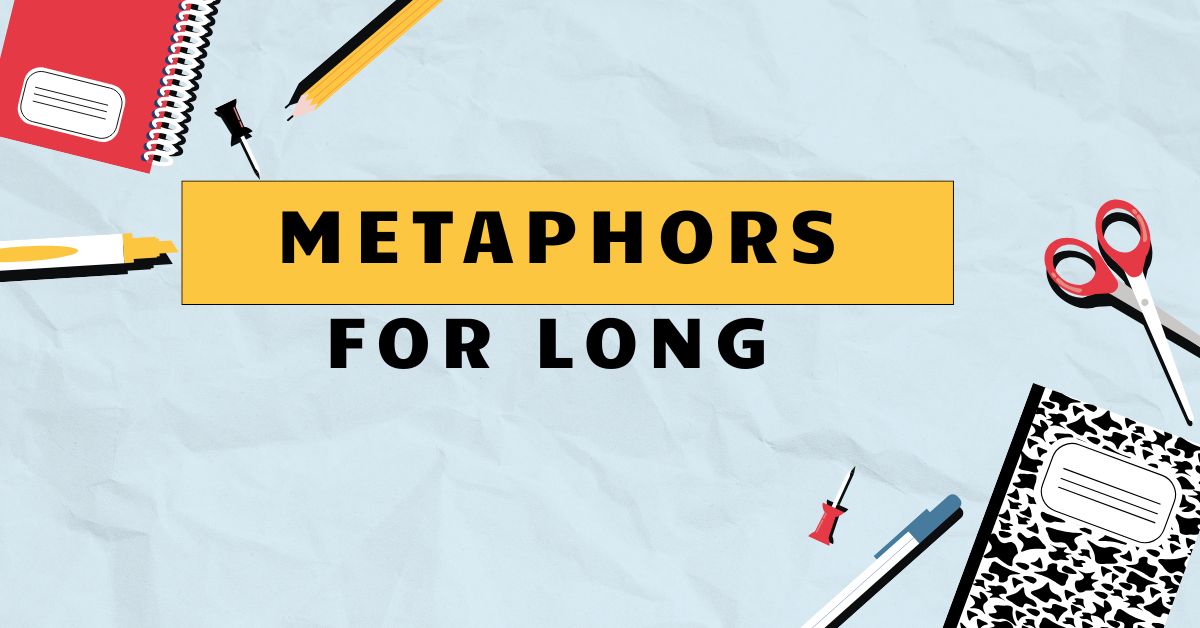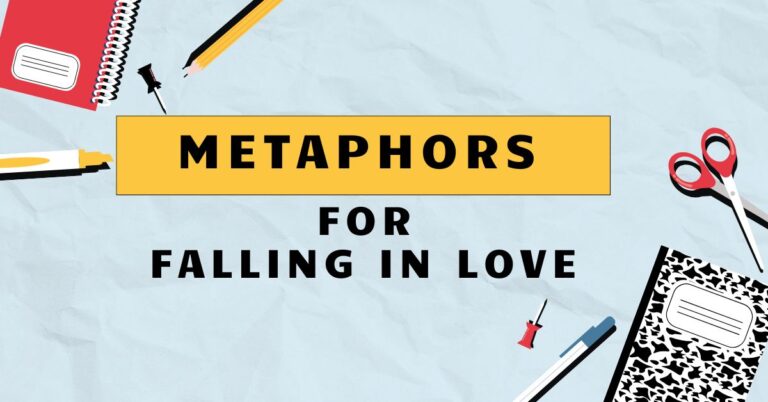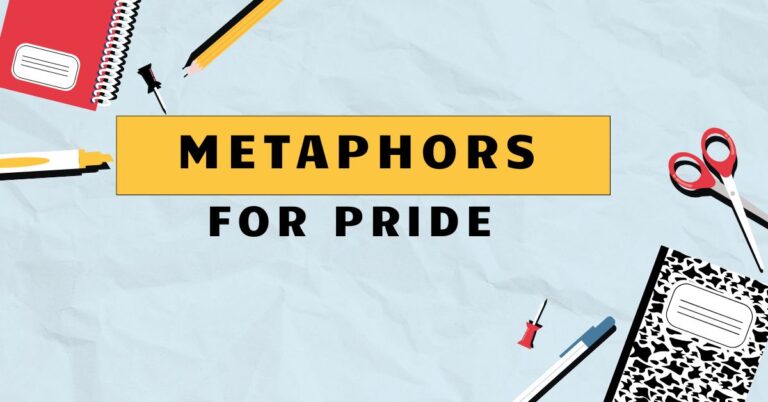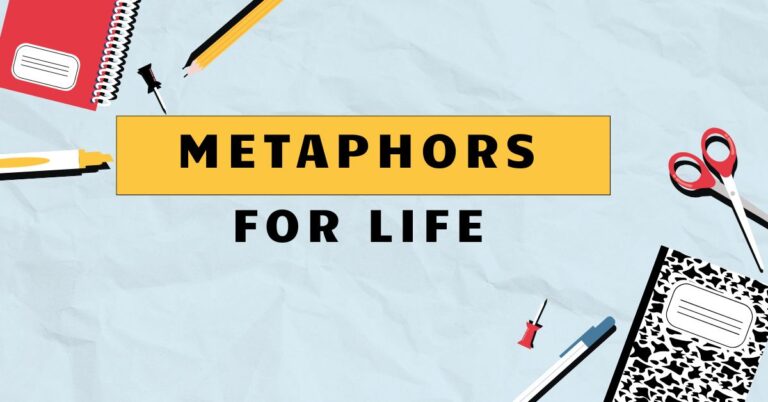27 Metaphors for Long: Understanding Extended Duration
Understanding how we use metaphors to describe the concept of “long” is crucial for mastering English. Metaphors allow us to express abstract ideas like time and duration in more concrete and relatable terms.
This article explores the various ways the English language uses metaphors to convey the idea of something being extended in time, helping you to not only understand but also effectively use these expressions in your own writing and speech. This guide is beneficial for English language learners of all levels, from beginners to advanced speakers, as well as anyone looking to refine their grasp of figurative language.
Table of Contents
- Introduction
- Definition of Metaphors for “Long”
- Structural Breakdown
- Types and Categories of Metaphors for “Long”
- Examples of Metaphors for “Long”
- Usage Rules
- Common Mistakes
- Practice Exercises
- Advanced Topics
- FAQ
- Conclusion
Definition of Metaphors for “Long”
Metaphors for “long” are figures of speech that use imaginative language to describe durations of time, events, or processes that extend for a considerable period. They move beyond literal descriptions to convey the feeling, impact, or nature of something that takes a significant amount of time.
The function of these metaphors is to make the abstract concept of time more tangible and relatable, allowing for a richer and more evocative expression of duration.
These metaphors are frequently used in both spoken and written English across a variety of contexts. You might encounter them in literature, where authors use them to enhance the emotional impact of their narratives.
They appear in everyday conversations, helping people express their experiences of time in a vivid way. Business communication also utilizes these metaphors, for example, when discussing long-term projects or extended deadlines.
Understanding these metaphors is essential for interpreting nuanced meanings and communicating effectively.
Structural Breakdown
The structure of metaphors for “long” typically involves mapping characteristics from a more concrete domain (like physical space or weight) onto the abstract domain of time. This mapping often follows a consistent pattern.
For example, the metaphor “a long road” maps the physical length of a road onto the duration of a journey or process. The key elements include:
- Source Domain: The concrete concept that provides the metaphorical basis (e.g., distance, weight).
- Target Domain: The abstract concept being described (e.g., duration, time).
- Mapping: The relationship between the source and target domains (e.g., greater distance equates to longer duration).
Consider the phrase “a long and winding road.” Here, the source domain is the physical characteristics of a road (length and winding nature). The target domain is a life’s journey or a challenging process.
The mapping connects the physical obstacles of the road to the challenges and obstacles faced during the journey. This structure allows for a deeper understanding and appreciation of the metaphorical meaning.
Types and Categories of Metaphors for “Long”
Metaphors for “long” can be categorized based on the conceptual domains they draw from. These categories help to understand the different ways we conceptualize and express extended duration.
Linear Progression Metaphors
These metaphors use the idea of a line or path to represent the passage of time. The length of the line corresponds to the duration of the event or process.
Examples include phrases like “a long timeline,” “a lengthy process,” or “a drawn-out affair.” These expressions emphasize the sequential and extended nature of the activity.
Weight and Burden Metaphors
These metaphors associate the experience of time with a sense of heaviness or burden. The longer the duration, the heavier the perceived weight.
Phrases like “a heavy silence,” “a burdensome wait,” or “a weighty decision” fall into this category. They highlight the emotional or psychological toll that a long period can take.
Distance and Journey Metaphors
These metaphors use the concept of a journey or distance to represent the time required to complete a task or reach a goal. The longer the journey, the greater the duration.
Examples include “a long road ahead,” “a marathon task,” or “a journey of a thousand miles.” These expressions often convey a sense of challenge, perseverance, and eventual accomplishment.
Endurance and Test Metaphors
These metaphors depict the experience of time as a test of one’s endurance or resilience. The longer the duration, the greater the test.
Phrases like “an ordeal,” “a trial by fire,” or “a test of patience” fall into this category. They emphasize the difficulty and strain associated with prolonged periods of waiting or suffering.
Stretching and Extension Metaphors
These metaphors use the idea of stretching or extending something to represent the prolongation of time. The more something is stretched, the longer the duration.
Examples include “stretched out negotiations,” “extended deadlines,” or “elongated discussions.” These expressions highlight the deliberate or sometimes unwelcome prolongation of an event or process.
Examples of Metaphors for “Long”
The following tables provide a comprehensive list of examples, organized by category, to illustrate the diverse ways metaphors are used to describe “long.”
The table below shows metaphors that employ the idea of linear progression to represent the passage of time. The length of the line or path corresponds to the duration of the event or process.
| Metaphor | Explanation |
|---|---|
| A long timeline | Represents an extended sequence of events. |
| A lengthy process | Indicates a procedure that takes considerable time. |
| A drawn-out affair | Suggests a situation that has been unnecessarily prolonged. |
| An extended period | A general term for a significant duration of time. |
| A prolonged negotiation | Describes a negotiation that has taken longer than expected. |
| A stretched-out meeting | Implies a meeting that has run longer than necessary. |
| A never-ending story | Conveys the feeling that something will continue indefinitely. |
| A sustained effort | Highlights the continuous and prolonged exertion of energy. |
| A continuous stream | Represents an uninterrupted flow of time or events. |
| A seamless transition | Describes a change that occurs smoothly over an extended period. |
| A gradual decline | Indicates a slow and progressive decrease over time. |
| A protracted debate | Suggests a debate that has been extended for a considerable time. |
| A running commentary | Implies a continuous commentary that lasts for an extended event. |
| A standing ovation | Describes an applause that continues for a significant period. |
| A creeping suspicion | Suggests a suspicion that develops slowly over time. |
| A lingering scent | Indicates a scent that remains for a prolonged period. |
| A trailing echo | Represents an echo that persists for a noticeable duration. |
| A sprawling narrative | Describes a narrative that covers a large amount of time and detail. |
| A sweeping change | Implies a change that occurs extensively over a period of time. |
| An unfolding drama | Suggests a drama that reveals itself gradually over time. |
| A winding path | Represents a path that extends with many turns and curves. |
| A flowing river | Implies an uninterrupted flow that continues for a long distance. |
| A spreading rumor | Suggests a rumor that propagates widely over time. |
The table below presents metaphors that use the concept of weight or burden to represent the experience of time. The longer the duration, the heavier the perceived weight.
| Metaphor | Explanation |
|---|---|
| A heavy silence | Indicates a silence that feels oppressive and prolonged. |
| A burdensome wait | Describes a wait that feels difficult and taxing. |
| A weighty decision | Suggests a decision that carries significant consequences and requires careful consideration over time. |
| A crushing blow | Implies a setback that feels devastating and long-lasting. |
| A grinding halt | Describes a gradual and difficult stop to progress. |
| A pressing issue | Suggests an issue that demands immediate and sustained attention. |
| A taxing endeavor | Implies an undertaking that is physically or mentally draining over time. |
| A ponderous task | Describes a task that requires careful and prolonged thought. |
| A cumbersome process | Indicates a process that is slow and difficult to manage. |
| A lingering doubt | Suggests a doubt that persists and weighs on one’s mind. |
| A heavy heart | Implies a feeling of sadness that lasts for an extended time. |
| A burdensome responsibility | Describes a responsibility that feels difficult and oppressive. |
| A grinding routine | Suggests a daily routine that feels monotonous and prolonged. |
| A crushing weight | Implies a burden that feels overwhelming and difficult to bear. |
| A pressing deadline | Suggests a deadline that demands immediate and sustained attention. |
| A heavy atmosphere | Indicates an environment that feels tense and oppressive. |
| A ponderous silence | Describes a silence that feels heavy and filled with unspoken thoughts. |
| A cumbersome regulation | Implies a regulation that is difficult to navigate and manage. |
| A lingering memory | Suggests a memory that persists and affects one’s emotions. |
| A heavy burden | Describes a responsibility or problem that feels oppressive. |
| A grinding poverty | Suggests a continuous and difficult state of poverty. |
| A pressing need | Implies a need that requires immediate and sustained attention. |
| A taxing problem | Describes a problem that is mentally draining and prolonged. |
The table below showcases metaphors that use the concept of distance or a journey to represent the time required to complete a task or reach a goal. The longer the journey, the greater the duration.
| Metaphor | Explanation |
|---|---|
| A long road ahead | Indicates that there is still much to be done before reaching a goal. |
| A marathon task | Describes a task that requires sustained effort and endurance. |
| A journey of a thousand miles | Suggests a long and challenging undertaking. |
| A winding path to success | Implies that the route to success is not direct or easy. |
| A circuitous route | Describes a route that is indirect and takes longer than necessary. |
| A meandering discussion | Suggests a discussion that wanders from topic to topic. |
| A long and arduous climb | Implies a difficult and prolonged effort to reach a goal. |
| A distant horizon | Represents a goal that is far off in the future. |
| A long voyage | Describes a journey that is extensive and prolonged. |
| A roundabout way | Suggests a method that is indirect and takes longer than necessary. |
| A long and winding road | Implies a life or situation filled with challenges and changes. |
| A pilgrimage | Describes a journey that is undertaken for a significant purpose. |
| A long haul | Suggests an effort that will require sustained commitment. |
| A scenic route | Implies a route that is enjoyable but may take longer. |
| A long and twisted path | Describes a path that is complex and difficult to navigate. |
| A meandering river | Suggests a river that flows in a winding and indirect course. |
| A long-distance relationship | Implies a relationship that requires sustained effort to maintain. |
| An extensive trek | Describes a journey that is long and often challenging. |
| A long and circuitous route | Suggests a route that is indirect and takes a considerable time. |
| A far-off destination | Represents a goal that is distant and requires significant effort. |
| A long campaign | Suggests an extensive and continuous effort toward a certain goal. |
| A protracted journey | Implies a journey that is extended and takes significant time. |
| A winding trail | Describes a trail that is complex and difficult to navigate. |
This table illustrates metaphors that depict the experience of time as a test of one’s endurance or resilience. The longer the duration, the greater the test.
| Metaphor | Explanation |
|---|---|
| An ordeal | Describes a difficult and prolonged experience. |
| A trial by fire | Suggests a challenging experience that tests one’s abilities. |
| A test of patience | Implies a situation that requires endurance and tolerance. |
| A prolonged struggle | Describes a continuous and difficult effort to overcome obstacles. |
| A battle of attrition | Suggests a conflict that is won by wearing down the opponent. |
| A long winter | Implies a period of hardship and difficulty. |
| A test of endurance | Describes a situation that requires sustained effort and resilience. |
| A prolonged drought | Suggests a period of scarcity and hardship. |
| A siege | Describes a prolonged period of being surrounded or under attack. |
| A long dry spell | Suggests a period without success or positive outcomes. |
| A test of will | Implies a situation that challenges one’s determination and resolve. |
| A prolonged period of uncertainty | Describes a time of doubt and instability. |
| A battle against time | Suggests a struggle to complete a task before a deadline. |
| A long and difficult road | Implies a path that is filled with challenges and obstacles. |
| A prolonged period of isolation | Describes a time of being alone and separated from others. |
| A crucible | Suggests a severe test or trial that leads to transformation. |
| A marathon effort | Describes an effort that requires sustained commitment and endurance. |
| A long wait | Implies a period of waiting that is extended and often frustrating. |
| A prolonged recovery | Describes a recovery process that takes a significant amount of time. |
| An uphill battle | Suggests a struggle that is difficult and requires significant effort. |
This table presents metaphors that use the idea of stretching or extending something to represent the prolongation of time. The more something is stretched, the longer the duration.
| Metaphor | Explanation |
|---|---|
| Stretched out negotiations | Describes negotiations that have been prolonged unnecessarily. |
| Extended deadlines | Implies deadlines that have been pushed further into the future. |
| Elongated discussions | Suggests discussions that have been made longer than necessary. |
| A drawn-out process | Describes a process that has been prolonged and made tedious. |
| A stretched budget | Suggests a budget that has been made to cover an extended period. |
| An expanded timeline | Implies a timeline that has been lengthened to accommodate more tasks. |
| A prolonged absence | Describes an absence that has lasted for a significant amount of time. |
| A stretched resource | Suggests a resource that has been made to cover an extended need. |
| Extended coverage | Describes coverage that has been made to last longer. |
| A prolonged exposure | Implies exposure that has lasted for a significant amount of time. |
| A stretched interpretation | Describes an interpretation that has been extended beyond its original scope. |
| A prolonged investigation | Suggests an investigation that has been extended for a considerable time. |
| An extended warranty | Implies a warranty that has been made to last longer. |
| A stretched canvas | Describes a canvas that has been extended to accommodate more material. |
| A prolonged debate | Suggests a debate that has been extended for a considerable time. |
| An elongated shadow | Implies a shadow that has been stretched due to the angle of light. |
| A stretched analogy | Describes an analogy that has been extended beyond its logical limits. |
| A prolonged silence | Implies a silence that has lasted for a significant amount of time. |
| An extended visit | Describes a visit that has been made longer than initially planned. |
| A stretched explanation | Suggests an explanation that has been extended to cover more details. |
Usage Rules
When using metaphors for “long,” it’s essential to ensure they are appropriate for the context and audience. Overusing metaphors can make your writing or speech sound contrived, while using inappropriate metaphors can confuse or mislead your audience.
Here are some guidelines:
- Consider the context: Choose metaphors that align with the overall tone and subject matter.
- Know your audience: Select metaphors that your audience will understand and appreciate.
- Avoid clichés: Steer clear of overused metaphors that have lost their impact. Instead, strive for originality.
- Be consistent: Maintain consistency in your metaphorical language throughout your writing or speech.
- Ensure clarity: Make sure the connection between the source and target domains is clear and logical.
Additionally, be mindful of cultural differences. Some metaphors may not translate well across different cultures, so it’s important to be aware of potential misunderstandings.
Common Mistakes
One common mistake is using mixed metaphors, where the source domains are incompatible. For example, saying “the project is a long road that’s also a piece of cake” combines the metaphor of a challenging journey with the metaphor of something easy, creating a confusing and illogical image.
Another mistake is overusing metaphors, which can make your writing sound forced and unnatural. It’s better to use a few well-chosen metaphors than to pepper your text with too many.
The table below shows common mistakes when using metaphors for “long.”
| Incorrect | Correct | Explanation |
|---|---|---|
| The long process was a walk in the park and a marathon. | The long process was a marathon. | Avoid mixing metaphors that create illogical comparisons. |
| The discussion stretched out like a rubber band, but it was also a fleeting moment. | The discussion stretched out like a rubber band. | Ensure metaphors are consistent and do not contradict each other. |
| The task was a long and winding road, but also a piece of cake. | The task was a long and winding road. | Do not combine metaphors that create confusing images. |
| The project was a long journey that was also a sprint. | The project was a long journey. | Choose metaphors that align with the extended duration. |
Practice Exercises
Test your understanding of metaphors for “long” with the following exercises.
Exercise 1: Identify the Metaphor
Identify the metaphor for “long” in each sentence.
| Question | Answer |
|---|---|
| 1. The negotiations became a drawn-out affair. | drawn-out affair |
| 2. The silence in the room was heavy and prolonged. | heavy and prolonged |
| 3. The road to recovery was a long and winding one. | long and winding one |
| 4. His illness was an ordeal that tested his strength. | an ordeal |
| 5. The project faced extended deadlines due to unforeseen issues. | extended deadlines |
| 6. The debate stretched out for hours without resolution. | stretched out |
| 7. The investigation turned into a marathon task. | marathon task |
| 8. The wait for the results felt like an eternity. | an eternity |
| 9. The trial became a battle of attrition. | battle of attrition |
| 10. Her absence was a prolonged period of uncertainty. | prolonged period of uncertainty |
Exercise 2: Fill in the Blank
Complete each sentence with an appropriate metaphor for “long.”
| Question | Answer |
|---|---|
| 1. The project turned into a _____, requiring more resources than anticipated. | long haul |
| 2. The trial was a _____, testing the defendant’s resolve. | trial by fire |
| 3. The negotiations were _____, with no end in sight. | stretched out |
| 4. The wait for the train felt like _____. | an eternity |
| 5. The process of learning a new language can be _____. | a long and winding road |
| 6. The _____ of the pandemic affected many people’s mental health. | prolonged period |
| 7. The _____ of the meeting bored everyone. | elongated discussion |
| 8. The _____ of the movie made it difficult to stay focused. | extended duration |
| 9. The _____ for the promotion was intense. | long wait |
| 10. The _____ of the project meant we had to work overtime. | extended timeline |
Exercise 3: Rewrite with Metaphors
Rewrite the following sentences using metaphors for “long.”
| Original Sentence | Rewritten Sentence |
|---|---|
| 1. The meeting lasted a very long time. | 1. The meeting stretched out like a rubber band. |
| 2. The investigation took a long time to complete. | 2. The investigation turned into a marathon task. |
| 3. Waiting for the results was a difficult and lengthy experience. | 3. The wait for the results was a burdensome ordeal. |
| 4. The process of healing was slow and gradual. | 4. The road to recovery was a long and winding one. |
| 5. The discussions went on for a very long time without any resolution. | 5. The discussions became a drawn-out affair with no end in sight. |
| 6. The project’s timeline was extended due to unforeseen circumstances. | 6. The project faced extended deadlines due to unforeseen circumstances. |
| 7. The performance lasted longer than expected, testing the audience’s patience. | 7. The performance was a test of the audience’s patience. |
| 8. The silence in the room was prolonged and uncomfortable. | 8. The silence in the room was heavy and prolonged. |
| 9. The journey to success was difficult and required sustained effort. | 9. The journey to success was a long and arduous climb. |
| 10. The task of completing the report took much longer than anticipated. | 10. The task of completing the report turned into a marathon. |
Advanced Topics
For advanced learners, exploring the cognitive linguistics behind metaphors can provide deeper insights. Conceptual Metaphor Theory, developed by George Lakoff and Mark Johnson, posits that metaphors are not just linguistic devices but fundamental aspects of how we think.
Understanding this theory can help you appreciate the pervasive influence of metaphors in shaping our understanding of the world.
Another advanced topic is the use of extended metaphors, where a single metaphor is developed and sustained throughout a piece of writing or speech. This technique can add depth and coherence to your communication, but it requires careful planning and execution.
FAQ
- What is a metaphor for “long”?
A metaphor for “long” is a figure of speech that uses imaginative language to describe durations of time, events, or processes that extend for a considerable period. It’s a way to make the abstract concept of time more tangible and relatable.
- Why are metaphors for “long” important?
They allow us to express the abstract concept of time in more concrete and relatable terms, making our communication more vivid and impactful. They also help us understand and interpret nuanced meanings in literature and everyday conversations.
- What are some common categories of metaphors for “long”?
Common categories include linear progression metaphors (e.g., “a long timeline”), weight and burden metaphors (e.g., “a heavy silence”), distance and journey metaphors (e.g., “a long road ahead”), endurance and test metaphors (e.g., “an ordeal”), and stretching and extension metaphors (e.g., “extended deadlines”).
- How can I avoid using clichés when using metaphors for “long”?
Strive for originality by creating your own metaphors or by putting a fresh spin on existing ones. Consider the specific context and try to find a unique way to express the idea of extended duration.
- What is a mixed metaphor, and how can I avoid it?
A mixed metaphor combines incompatible source domains, creating a confusing and illogical image. To avoid it, ensure that your metaphors are consistent and that the connections between the source and target domains are clear and logical.
- How can I use metaphors for “long” effectively in my writing?
Choose metaphors that are appropriate for the context and audience, avoid overusing them, and ensure that they are clear and consistent. Use them to enhance the emotional impact and make your writing more engaging.
- Are there any cultural considerations when using metaphors for “long”?
Yes, some metaphors may not translate well across different cultures. Be aware of potential misunderstandings and consider using metaphors that are universally understood or that are relevant to the specific cultural context.
- What is Conceptual Metaphor Theory, and how does it relate to metaphors for “long”?
Conceptual Metaphor Theory posits that metaphors are not just linguistic devices but fundamental aspects of how we think. Understanding this theory can help you appreciate the pervasive influence of metaphors in shaping our understanding of abstract concepts like time and duration.
- How can I use extended metaphors to describe “long”?
An extended metaphor is where a single metaphor is developed and sustained throughout a piece of writing or speech. This technique can add depth and coherence to your communication, but it requires careful planning and execution. For example, you could compare a difficult project to a long sea voyage, developing the metaphor with descriptions of storms, calm seas, and the eventual arrival at the destination.
- What are some resources for learning more about metaphors?
Books like “Metaphors We Live By” by George Lakoff and Mark Johnson, and websites dedicated to cognitive linguistics, can provide deeper insights into the world of metaphors. Additionally, analyzing literary works and paying attention to how metaphors are used in everyday conversations can enhance your understanding.
Conclusion
Mastering the use of metaphors for “long” enhances your ability to express duration in vivid and engaging ways. By understanding the different types of metaphors, following usage rules, avoiding common mistakes, and practicing with exercises, you can refine your language skills and communicate more effectively.
The key takeaway is to be mindful of context, audience, and consistency when incorporating these metaphors into your writing and speech.
Remember that metaphors are powerful tools that can transform abstract ideas into relatable experiences. By continuing to explore and experiment with metaphorical language, you will not only improve your English proficiency but also enrich your overall communication skills.
Practice regularly, analyze examples from literature and everyday conversations, and embrace the creativity that metaphors offer to become a more articulate and expressive communicator.







